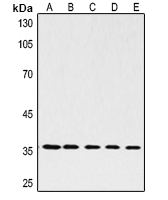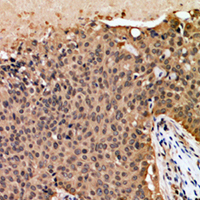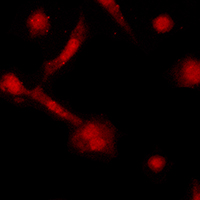Description:Mouse monoclonal antibody to GAPDHImmunogen:Recombinant protein corresponding to GAPDH.Purification:The antibody was purified by immunogen affinity chromatography.Clonality:MonoclonalForm:Liquid in 0.42% Potassium phosphate, 0.87% Sodium chloride, pH 7.3, 0.2% BSA, 30% glycerol, and 0.01% sodium azide.Dilution:WB (1/3000 - 1/10000), IH (1/50 - 1/100), IF/IC (1/50 - 1/100)Gene Symbol:GAPDHAlternative Names:GAPD; Glyceraldehyde-3-phosphate dehydrogenase; GAPDH; Peptidyl-cysteine S-nitrosylase GAPDH
Entrez Gene (Human):
2597;
Entrez Gene (Mouse):
100042025;
Entrez Gene (Rat):
24383;
SwissProt (Human):
P04406;
SwissProt (Mouse):
P16858;
SwissProt (Rat):
P04797;
Storage/Stability:Shipped at 4°C. Upon delivery aliquot and store at -20°C for one year. Avoid freeze/thaw cycles.
-
 Western blot analysis of GAPDH expression in Hela (A), mouse brain (B), mouse spleen (C), rat liver (D), rat lung (E) whole cell lysates. (Predicted band size: 36 kD; Observed band size: 36 kD)
Western blot analysis of GAPDH expression in Hela (A), mouse brain (B), mouse spleen (C), rat liver (D), rat lung (E) whole cell lysates. (Predicted band size: 36 kD; Observed band size: 36 kD) -
 Immunohistochemical analysis of GAPDH staining in human breast cancer formalin fixed paraffin embedded tissue section. The section was pre-treated using heat mediated antigen retrieval with sodium citrate buffer (pH 6.0). The section was then incubated with the antibody at room temperature and detected using an HRP conjugated compact polymer system. DAB was used as the chromogen. The section was then counterstained with haematoxylin and mounted with DPX.
Immunohistochemical analysis of GAPDH staining in human breast cancer formalin fixed paraffin embedded tissue section. The section was pre-treated using heat mediated antigen retrieval with sodium citrate buffer (pH 6.0). The section was then incubated with the antibody at room temperature and detected using an HRP conjugated compact polymer system. DAB was used as the chromogen. The section was then counterstained with haematoxylin and mounted with DPX. -
 Immunofluorescent analysis of GAPDH staining in HeLa cells. Formalin-fixed cells were permeabilized with 0.1% Triton X-100 in TBS for 5-10 minutes and blocked with 3% BSA-PBS for 30 minutes at room temperature. Cells were probed with the primary antibody in 3% BSA-PBS and incubated overnight at 4 °C in a humidified chamber. Cells were washed with PBST and incubated with a DyLight 594-conjugated secondary antibody (red) in PBS at room temperature in the dark.
Immunofluorescent analysis of GAPDH staining in HeLa cells. Formalin-fixed cells were permeabilized with 0.1% Triton X-100 in TBS for 5-10 minutes and blocked with 3% BSA-PBS for 30 minutes at room temperature. Cells were probed with the primary antibody in 3% BSA-PBS and incubated overnight at 4 °C in a humidified chamber. Cells were washed with PBST and incubated with a DyLight 594-conjugated secondary antibody (red) in PBS at room temperature in the dark.
Bergamottin protects against LPS-induced endotoxic shock by regulating the NF-κB signaling pathway
ML365 inhibits lipopolysaccharide-induced inflammatory responses via the NF-κB signaling pathway
Clozapine blunts mitochondrial biogenesis in differentiating adipocytes: The increased ATP demand is met via stimulation of electron transport chain expression and activity in residual mitochondria


 Datasheet
Datasheet MSDS
MSDS